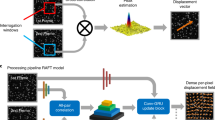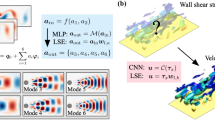Abstract
Particle image velocimetry (PIV) has been extensively used in wind-tunnel test for flow-field measurement. However, the sampling frequency of traditional PIV is low and physics of flow field in high-frequency range is hard to capture. A data processing approach is proposed to obtain time-resolved flow field around a circular cylinder with PIV measurement data (high spatial precision) and wind speed measurement data using probes (high time resolution at discrete downstream locations). Proper orthogonal decomposition (POD) is used to extract the compact spatial representations of the flow field based on PIV measurement data, and bidirectional recurrent neural networks (RNNs) with gated recurrent units are designed to learn the time sequences of coefficients of the first few POD modes based on both PIV and probe measurement data. We analyze qualitatively the relationship between the velocity time sequence and the spatial distribution of velocity. Based on this qualitative relationship, an RNN with a unique “many-to-one” architecture is designed to learn the coefficients and make use of the intrinsic property that the velocity time sequence contains information on the spatial distribution of velocity. The inputs to the RNN are the sequential velocity-probe measurements with high sampling frequency, and the outputs are the coefficients of the first few POD modes. The proposed approach is validated by using both simulated datasets for two low Reynolds numbers (200 and 500) and experimental dataset for Reynolds number of 2.4 × 104. We also investigate the influence of velocity time length used in the inputs as well as the number and distribution of velocity probes on prediction accuracy. This study provides a feasible approach to get time-resolved flow field with high accuracy while low cost for all Reynolds numbers.
Graphic abstract


























Similar content being viewed by others
References
Adrian RJ, Jones BG, Chung MK, Hassan Y, Nithianandan CK, Tung ATC (1989) Approximation of turbulent conditional averages by stochastic estimation. Phys Fluids A Fluid Dyn 1:992–998. https://doi.org/10.1063/1.857411
Bergstra J, Bengio Y (2012) Random search for hyper-parameter optimization. J Mach Learn Res 13:281–305
Bishop CM (1995) Regularization and complexity control in feed-forward networks. In: Proceedings international conference on artificial neural networks ICANN, Paris, France, pp 141–148
Borée J (2003) Extended proper orthogonal decomposition: a tool to analyse correlated events in turbulent flows. Exp Fluids 35:188–192
Bourgeois J, Noack B, Martinuzzi R (2013) Generalized phase average with applications to sensor-based flow estimation of the wall-mounted square cylinder wake. J Fluid Mech 736:316–350
Brochu E, Cora VM, De Freitas N (2010) A tutorial on Bayesian optimization of expensive cost functions, with application to active user modeling and hierarchical reinforcement learning. Preprint, arXiv:1012.2599
Cho K, Van Merriënboer B, Gulcehre C, et al (2014) Learning phrase representations using RNN encoder-decoder for statistical machine translation. Preprint, arXiv:1406.1078
Deane AE, Kevrekidis IG, Karniadakis GE, Orszag SA (1991) Low-dimensional models for complex geometry flows: application to grooved channels and circular cylinders. Phys Fluids A Fluid Dyn 3:2337–2354. https://doi.org/10.1063/1.857881
Discetti S, Bellani G, Örlü R et al (2019) Characterization of very-large-scale motions in high-Re pipe flows. Exp Therm Fluid Sci 104:1–8
Discetti S, Raiola M, Ianiro A (2018) Estimation of time-resolved turbulent fields through correlation of non-time-resolved field measurements and time-resolved point measurements. Exp Therm Fluid Sci 93:119–130
Druault P, Guibert P, Alizon F (2005) Use of proper orthogonal decomposition for time interpolation from PIV data. Exp Fluids 39:1009–1023
Duraisamy K, Iaccarino G, Xiao H (2019) Turbulence modeling in the age of data. Annu Rev Fluid Mech 51:357–377
Durgesh V, Naughton J (2010) Multi-time-delay LSE-POD complementary approach applied to unsteady high-Reynolds-number near wake flow. Exp Fluids 49:571–583
Gerhard J, Pastoor M, King R, et al (2003) Model-based control of vortex shedding using low-dimensional Galerkin models. In: 33rd AIAA fluid dynamics conference and exhibit, p 4262
Germano M, Piomelli U, Moin P, Cabot WH (1991) A dynamic subgrid-scale eddy viscosity model. Phys Fluids A Fluid Dyn 3:1760–1765
Goodfellow I, Bengio Y, Courville A (2016) Deep learning. MIT Press, Cambridge
He C, Liu Y (2017) Proper orthogonal decomposition-based spatial refinement of TR-PIV realizations using high-resolution non-TR-PIV measurements. Exp Fluids 58:86. https://doi.org/10.1007/s00348-017-2371-5
He G, Jin G, Yang Y (2017) Space-time correlations and dynamic coupling in turbulent flows. Annu Rev Fluid Mech 49:51–70
Hochreiter S, Schmidhuber J (1997) Long short-term memory. Neural Comput 9:1735–1780. https://doi.org/10.1162/neco.1997.9.8.1735
Hosseini Z, Martinuzzi RJ, Noack BR (2015) Sensor-based estimation of the velocity in the wake of a low-aspect-ratio pyramid. Exp Fluids 56:13
Hudy LM, Naguib A, Humphreys WM (2007) Stochastic estimation of a separated-flow field using wall-pressure-array measurements. Phys Fluids 19:024103
Jeong J, Hussain F (1995) On the identification of a vortex. J Fluid Mech 285:69–94. https://doi.org/10.1017/s0022112095000462
Jin X, Cheng P, Chen W-L, Li H (2018) Prediction model of velocity field around circular cylinder over various Reynolds numbers by fusion convolutional neural networks based on pressure on the cylinder. Phys Fluids 30:047105
Kerhervé F, Roux S, Mathis R (2017) Combining time-resolved multi-point and spatially-resolved measurements for the recovering of very-large-scale motions in high Reynolds number turbulent boundary layer. Exp Therm Fluid Sci 82:102–115
Kingma DP, Ba J (2015) Adam: a method for stochastic optimization. In: The third international conference on learning representations. San Diego, CA, USA arXiv:1412.6980
Konstantinidis E, Balabani S, Yianneskis M (2007) Bimodal vortex shedding in a perturbed cylinder wake. Phys Fluids 19:011701
Kutz JN (2017) Deep learning in fluid dynamics. J Fluid Mech 814:1–4. https://doi.org/10.1017/jfm.2016.803
Labbé D, Wilson P (2007) A numerical investigation of the effects of the spanwise length on the 3-D wake of a circular cylinder. J Fluids Struct 23:1168–1188
LeCun Y, Bengio Y, Hinton G (2015) Deep learning. Nature 521:436–444. https://doi.org/10.1038/nature14539
Lee S, You D (2018) Data-driven prediction of unsteady flow fields over a circular cylinder using deep learning. Preprint arXiv:1804.06076
Lilly DK (1992) A proposed modification of the Germano subgrid-scale closure method. Phys Fluids A Fluid Dyn 4:633–635
Lin C-C (1953) On Taylor’s hypothesis and the acceleration terms in the Navier-Stokes equation. Q Appl Math 10:295–306
Liu P, Qiu X, Huang X (2016) Recurrent neural network for text classification with multi-task learning. In: Proceedings of the twenty-fifth international joint conference on artificial intelligence. AAAI Press, Palo Alto, California USA, pp 2873–2879
Loiseau J-C, Noack BR, Brunton SL (2018) Sparse reduced-order modelling: sensor-based dynamics to full-state estimation. J Fluid Mech 844:459–490
Losse NR, King R, Zengl M, Rist U, Noack BR (2011) Control of Tollmien-Schlichting instabilities by finite distributed wall actuation. Theor Comput Fluid Dyn 25:167–178
Mittal R, Balachandar S (1995) Effect of three-dimensionality on the lift and drag of nominally two-dimensional cylinders. Phys Fluids 7:1841–1865
Munson BR, Young DF, Okiishi TH (2009) Fundamentals of fluid dynamics. Wiley, Hoboken
Noack BR, Afanasiev K, Morzyński M, Tadmor G, Thiele F (2003) A hierarchy of low-dimensional models for the transient and post-transient cylinder wake. J Fluid Mech 497:335–363
Noack BR, Morzynski M, Tadmor G (2011) Reduced-order modelling for flow control. Springer, Berlin
Noack BR, Papas P, Monkewitz PA (2005) The need for a pressure-term representation in empirical Galerkin models of incompressible shear flows. J Fluid Mech 523:339–365
Noack BR, Stankiewicz W, Morzyński M, Schmid PJ (2016) Recursive dynamic mode decomposition of transient and post-transient wake flows. J Fluid Mech 809:843–872
Norberg C (2001) Flow around a circular cylinder: aspects of fluctuating lift. J Fluids Struct 15:459–469
Oberleithner K, Sieber M, Nayeri C et al (2011) Three-dimensional coherent structures in a swirling jet undergoing vortex breakdown: stability analysis and empirical mode construction. J Fluid Mech 679:383–414
Raissi M, Perdikaris P, Karniadakis GE (2019) Physics-informed neural networks: a deep learning framework for solving forward and inverse problems involving nonlinear partial differential equations. J Comput Phys 378:686–707. https://doi.org/10.1016/j.jcp.2018.10.045
Relf E, Simmons LFG (1924) The frequency of the eddies generated by the motion of circular cylinders through a fluid. HM Stationery Office, Richmond
Schuster M, Paliwal KK (1997) Bidirectional recurrent neural networks. IEEE Trans Signal Process 45:2673–2681
Sirovich L (1987) Turbulence and the dynamics of coherent structures Part I: Coherent structures. Q Appl Math 45:561–571
Sjoberg J, Ljung L (1995) Overtraining, regularization and searching for a minimum, with application to neural networks. Int J Control 62:1391–1407
Taylor GI (1938) The spectrum of turbulence. Proc R S Lond Ser A Math Phys Sci 164:476–490
Tinney CE, Coiffet F, Delville J, Hall A, Jordan P, Glauser MN (2006) On spectral linear stochastic estimation. Exp Fluids 41:763–775
Tinney CE, Ukeiley L, Glauser MN (2008) Low-dimensional characteristics of a transonic jet Part 2 Estimate and far-field prediction. J Fluid Mech 615:53–92
Tu JH, Griffin J, Hart A, Rowley CW, Cattafesta LN, Ukeiley LS (2013) Integration of non-time-resolved PIV and time-resolved velocity point sensors for dynamic estimation of velocity fields. Exp Fluids 54:1429
Williamson CH (1996) Vortex dynamics in the cylinder wake. Annu Rev Fluid Mech 28:477–539
Xiao H, Wu J-L, Wang J-X, Sun R, Roy C (2016) Quantifying and reducing model-form uncertainties in Reynolds-averaged Navier-Stokes simulations: a data-driven, physics-informed Bayesian approach. J Comput Phys 324:115–136
Acknowledgements
This research was funded by the National Natural Science Foundation of China (NSFC) (Grants No. U1711265, No. 51878230 and No. 51722805).
Author information
Authors and Affiliations
Corresponding author
Additional information
Publisher's Note
Springer Nature remains neutral with regard to jurisdictional claims in published maps and institutional affiliations.
Rights and permissions
About this article
Cite this article
Jin, X., Laima, S., Chen, WL. et al. Time-resolved reconstruction of flow field around a circular cylinder by recurrent neural networks based on non-time-resolved particle image velocimetry measurements. Exp Fluids 61, 114 (2020). https://doi.org/10.1007/s00348-020-2928-6
Received:
Revised:
Accepted:
Published:
DOI: https://doi.org/10.1007/s00348-020-2928-6




